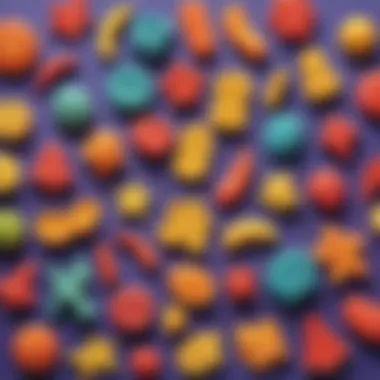Unlocking Creativity: The Ultimate Play Dough Recipe for Young Scientists


Science Fun Facts
Let us delve into some captivating science trivia and unearth quirky stories that will intrigue young minds. How about exploring amazing records set in the realm of science or pondering over thought-provoking questions that spark curiosity? Science is a treasure trove of fascinating details waiting to be discovered.
Discover the Wonders of Science
Dive into the world of scientific concepts with engaging educational videos, interactive animations, and tools that make learning fun and enlightening. Witness the real-life applications of science in everyday scenarios, bridging the gap between theory and practice. Unveil the beauty and practicality of scientific knowledge in a captivating journey of discovery.
Science Quiz Time
Engage in interactive quizzes designed to test your knowledge and stimulate critical thinking. Challenge yourself with multiple-choice questions that tickle your brain cells or solve brain teasers and puzzles that enhance problem-solving skills. Experience the thrill of learning through gamification as you explore the interactive world of science quizzes.
Science Experiment Showcase
Embark on a journey of fun and learning with exciting science experiments that bring theory to life. Follow step-by-step instructions to conduct experiments, explore a curated materials list, and adhere to safety tips and precautions to ensure a safe scientific exploration. Unleash your inner scientist with hands-on experiments that ignite curiosity and foster a love for discovery.
Introduction to Play Dough
In this article, we delve into the fascinating world of play dough, a versatile material that serves as an excellent tool for early childhood development. Play dough is not just a simple toy; it plays a crucial role in enhancing children's cognitive and physical abilities. Understanding the properties and benefits of play dough is essential for parents and educators looking to engage young learners in meaningful and educational activities. By exploring the various aspects of play dough, we aim to highlight its significance in promoting children's creativity, imagination, and scientific inquiry. This section will provide a comprehensive overview of the importance of play dough in early learning, shedding light on its various benefits and applications.
Understanding the Importance of Play Dough in Early Learning
The sensory benefits of play dorguh
One of the key aspects of play dough that sets it apart as a valuable educational tool is its sensory benefits. The tactile nature of play dough stimulates children's senses, allowing them to explore different textures, shapes, and forms. By engaging with play dough, young learners develop their fine motor skills, hand-eye coordination, and sensory awareness. The malleability of play dough offers a sensory-rich experience, encouraging children to squeeze, mold, and manipulate the material in creative ways. Moreover, the sensory stimulation provided by play dough enhances children's cognitive development and artistic expression.
The role of play dough in fosternig creativity and imagination
Another crucial aspect of play dough is its ability to foster creativity and imagination in children. Unlike pre-made toys, play dough empowers young minds to experiment, invent, and express themselves freely. Through play dough, children can transform simple shapes into intricate designs, create imaginary worlds, and engage in pretend play scenarios. The open-ended nature of play dough invites children to think outside the box, encouraging them to explore new ideas and solutions. By tapping into their creativity and imagination, children can develop essential skills such as problem-solving, innovation, and critical thinking. Play dough serves as a blank canvas on which children can unleash their creativity, providing a platform for self-expression and artistic discovery.
Ingredients for Homemade Play Dough
In this section, we will delve into the crucial aspect of creating homemade play dough - the ingredients. Understanding the significance of each component is essential to achieve the perfect texture and consistency that will enhance the play dough experience for children. By carefully selecting and combining the right ingredients, we can create a sensory-rich and long-lasting play material that promotes creativity and learning.
Basic Ingredients


All-purpose flour
All-purpose flour is a fundamental element in play dough recipes due to its binding properties. With its fine texture and ability to hold other ingredients together, all-purpose flour forms the base structure of the play dough. This versatile ingredient is popular for its widespread availability and affordability, making it a practical choice for homemade play dough projects. While all-purpose flour provides the necessary consistency to the dough, it is crucial to ensure the right ratio is maintained to prevent stickiness or dryness, leading to a balanced and enjoyable tactile experience for young learners.
Salt
Salt serves a dual purpose in play dough - it enhances the dough's elasticity and acts as a preservative, increasing its longevity. Through its interaction with other ingredients, salt contributes to the overall texture and malleability of the play dough, allowing children to shape and mold it easily. The presence of salt also prevents bacterial growth, extending the shelf life of the play dough for prolonged use. However, it is important to moderate the salt content carefully to avoid overpowering the dough with a salty taste, ensuring a safe and enjoyable play experience.
Cream of tartar
Cream of tartar is a key ingredient that plays a vital role in maintaining the play dough's smoothness and flexibility. Known for its stabilizing properties, cream of tartar prevents the dough from becoming sticky or brittle, resulting in a pliable and durable consistency. This ingredient acts as a natural thickening agent, aiding in the cohesion of the dough while enhancing its elasticity. By incorporating cream of tartar, the play dough retains its softness and shape over time, supporting extended play sessions and creative exploration for children.
Vegetable oil
Vegetable oil acts as a lubricant in play dough, contributing to its silkiness and preventing the dough from sticking to hands or surfaces. This essential ingredient adds moisture to the mixture, ensuring a smooth and non-sticky texture that facilitates sculpting and shaping. By incorporating vegetable oil, the play dough becomes more pliable and easy to manipulate, enhancing the tactile experience for young learners. However, it is important to regulate the amount of vegetable oil to maintain the proper balance of moisture, preventing the dough from becoming too greasy or soggy.
Step-by-Step Play Dough Recipe
In this section, we delve into the intricacies of the step-by-step play dough recipe, a core element of our fun and educational journey. Crafting play dough is not merely a task, but a gateway to developing essential skills and understanding scientific concepts in a hands-on manner.
Play dough creation serves as a tactile and stimulating experience, engaging young learners in the realms of texture, cohesion, and transformation. The process inherently involves various sensory inputs that promote cognitive development and creativity, making it a valuable tool for educational exploration.
While following the step-by-step instructions, children not only mix ingredients but also delve into the realm of chemistry, albeit in a simplified form. It introduces them to the basic principles of combining elements to create a new substance and encourages them to observe changes in materials through active participation.
The careful execution of each stage in the play dough recipe cultivates patience and precision in young minds. From measuring ingredients accurately to observing the dough's consistency, every step hones fine motor skills and fosters a sense of accomplishment.
Preparation Process
Instructions for mixing dry ingredients
The importance of mixing dry ingredients lies in the foundation of play dough creation. This step sets the tone for the entire process, ensuring uniform distribution of components for a smooth and pliable end product.
The meticulous blending of all-purpose flour, salt, and cream of tartar is crucial for achieving the desired texture and malleability. Each ingredient plays a vital role in determining the dough's consistency, with salt enhancing pliability and cream of tartar aiding in elasticity.
Mixing the dry ingredients serves as a fundamental step in chemistry exploration, allowing children to witness how different powders combine to form a cohesive mixture. It initiates them into the realm of substance transformation, laying a basic foundation for understanding chemical reactions.
Engaging in the mixing process not only develops children's motor skills but also introduces them to scientific methodology. Observing the homogeneous blend of powders instills a sense of curiosity and discovery, fostering a natural inclination towards experimental learning.


Heating the mixture on a stove
Diving into the realm of heat application, the heating process holds a key role in transforming the raw ingredients into a cohesive dough. Heating the mixture on a stove acts as a catalyst, accelerating chemical interactions and enhancing the dough's structural integrity.
The controlled application of heat facilitates the activation of cream of tartar, promoting cohesion within the mixture. This step also aids in moisture evaporation, leading to the desired consistency and preventing the dough from becoming overly sticky.
Through heating, children observe the effects of temperature on materials, witnessing firsthand how energy influences the physical properties of substances. This experiential learning opportunity not only reinforces scientific concepts but also hones their observational skills.
Kneading the dough to achieve desired consistency
The final stage of kneading plays a pivotal role in fine-tuning the play dough's properties to meet the desired standards. Kneading involves both tactile and visual cues, allowing children to actively mold and shape the dough to their preference.
During the kneading process, children exert pressure on the dough, promoting muscle strength and coordination. This repetitive motion enhances their sensory awareness, refining their ability to gauge firmness and elasticity.
Kneading serves as a creative outlet, enabling young learners to explore different textures and forms through manipulation. It encourages experimentation and adaptability, as they adjust their techniques to achieve varying consistencies.
Moreover, kneading prompts children to engage in goal-oriented tasks, where they strive to achieve a specific outcome through iterative actions. This process instills a sense of determination and resilience, nurturing a growth mindset in their educational pursuits.
Colorful Variations and Additions
In the realm of homemade play dough, embracing colorful variations and additions opens a world of creativity and sensory exploration for young scientists. The incorporation of hues and scents elevates the play experience, enticing children to engage in a tactile journey that stimulates their senses and imagination. By introducing various colors and intriguing scents, we enhance the educational value of this hands-on activity, fostering a deeper understanding of materials and their properties.
By infusing play dough with vibrant hues using food coloring, we introduce children to the concept of color mixing and customization. The vivid colors not only appeal to the visual senses but also encourage experimentation and artistic expression. Through this process, young learners can explore the relationship between primary colors and discover the magic of blending shades to create new tones, enhancing their creativity and understanding of basic color theory. The use of food coloring for vibrant hues offers a practical and safe way to add visual appeal to the play dough, allowing children to personalize their creations with ease.
The addition of essential oils for sensory exploration brings a new dimension to the play dough experience, infusing each batch with captivating scents that evoke different feelings and memories. Essential oils not only engage the olfactory senses but also provide potential therapeutic benefits, promoting relaxation or invigoration during play. This multisensory approach allows children to explore the interconnected nature of their senses and develop a deeper appreciation for the role of scent in enhancing their overall experience. While adding essential oils for sensory exploration can enrich the sensory play experience, it is essential to consider individual sensitivities and opt for child-friendly scents to ensure a safe and enjoyable activity.
Exploring natural dye options for eco-friendly alternatives offers a sustainable twist to traditional play dough recipes, aligning the activity with environmental consciousness. By utilizing natural dyes derived from ingredients like fruits, vegetables, or spices, children can witness firsthand the potential of nature-based colorants and their impact on the play dough's hues. This eco-friendly approach not only promotes resourcefulness and creativity but also instills a sense of responsibility towards the environment, encouraging young learners to consider sustainable practices in their daily activities. While exploring natural dye options for play dough, it is crucial to research suitable sources and ensure compatibility with the chosen recipe to achieve desired color results effectively.
Educational Benefits of Play Dough
In the realm of childhood development, Play Dough emerges as a versatile tool that not only entertains but also educates. Its malleable nature stimulates various senses, aiding in sensory development. Moreover, as children engage in shaping and molding the dough, they hone their fine motor skills, enhancing coordination and dexterity. The process of kneading and working with Play Dough also encourages creativity and imagination, essential elements in early learning. Through hands-on exploration, young minds delve into the realm of basic chemistry concepts, providing a tangible experience that complements theoretical knowledge. Play Dough serves as a medium for scientific inquiry and problem-solving, prompting critical thinking and experimentation in a playful setting.
Enhancing Learning Through Play
Developing fine motor skills


Delving into the nuances of developing fine motor skills through play with Play Dough reveals a fundamental aspect of early childhood education. As children pinch, roll, and mold the dough, they engage muscles in their hands and fingers, fostering precision and control. This tactile experience aids in hand-eye coordination, an essential skill for tasks such as writing and drawing. The repetitive actions involved in working with Play Dough strengthen neural connections, enhancing fine motor skills over time. This tactile feedback not only refines physical capabilities but also contributes to cognitive development by linking sensory input to motor output.
Understanding basic chemistry concepts through hands-on exploration
Unlocking the world of basic chemistry concepts becomes an interactive journey with Play Dough as the vehicle. By blending ingredients and observing transformations, children grasp foundational principles such as the role of components in a mixture. The hands-on nature of crafting Play Dough allows young learners to experience chemical reactions firsthand, demystifying abstract theories. Through experimentation and observation, children develop a preliminary understanding of concepts like solubility, composition, and transformation, setting a solid foundation for future scientific inquiries.
Promoting scientific inquiry and problem-solving skills
Embracing Play Dough as a catalyst for scientific inquiry nurtures a spirit of curiosity and exploration. By posing questions and formulating hypotheses through play, children cultivate problem-solving skills in a dynamic environment. The trial-and-error process inherent in manipulating Play Dough encourages resilience and adaptability when faced with challenges. Through open-ended exploration, little scientists learn to think critically, analyze outcomes, and adjust their approach, laying the groundwork for a lifelong passion for discovery and experimentation.
Storage and Maintenance Tips
In the realm of creating play dough at home for our little science buddies, understanding the significance of storage and maintenance tips is paramount. Properly preserving play dough ensures its longevity and quality, allowing for continued enjoyment and educational exploration. By incorporating effective storage techniques and maintenance strategies, caregivers can uphold the integrity of the play dough, offering a consistent and conducive tactile experience for young learners.
Storage and maintenance not only extend the lifespan of play dough but also contribute to the overall learning experience. Implementing best practices in storing play dough can prevent it from drying out prematurely, thereby maintaining its pliability and texture. Caregivers play a vital role in overseeing the storage process to facilitate a seamless and engrossing play dough activity for children.
One fundamental aspect of preserving play dough quality lies in employing proper storage techniques to prevent drying out. By sealing the play dough in airtight containers after each use, moisture loss is minimized, preserving the malleability of the dough. Store-bought airtight containers or resealable plastic bags serve as effective solutions for maintaining the play dough's moisture content, safeguarding its usability for future play sessions.
Proper Storage Techniques to Prevent Drying Out: The key characteristic of this approach is its ability to retain moisture within the play dough, preventing desiccation and brittleness. By encapsulating the dough in an airtight environment, exposure to external elements is minimized, ensuring that the play dough remains supple and ready for play. This method offers a convenient and reliable means of safeguarding the play dough's quality, supporting extended use and educational engagement.
Conversely, another vital consideration pertains to extending the shelf life of homemade play dough through practical tips and techniques. By implementing strategies to prolong the longevity of the dough, caregivers can maximize its utility, reducing waste and promoting sustainability in the learning process. Offering insights into enhancing the durability of homemade play dough empowers caregivers to optimize resources and provide ongoing creative opportunities for children.
Tips for Prolonging the Shelf Life of Homemade Play Dough: The distinctive feature of this approach lies in its ability to enhance the longevity of the play dough, allowing for extended play sessions over time. By incorporating ingredients like glycerin or cream of tartar, caregivers can improve the dough's elasticity and resilience, prolonging its usability. This method presents a practical and efficient means of preserving homemade play dough, aligning with sustainability goals and facilitating continuous play experiences for young learners.
Conclusion
In concluding this comprehensive guide to creating play dough at home, the significance of engaging young minds through hands-on activities cannot be overstated. Encouraging children to explore and experiment fosters a deep understanding of materials and their properties, laying the foundation for future scientific inquiry. By incorporating play dough into educational activities, children aged 6-12 can develop fine motor skills, unleash their creativity, and grasp basic chemistry concepts through interactive play. This DIY project not only entertains but also educates, promoting meaningful learning experiences that go beyond traditional methods. The hands-on approach to learning offered by play dough creation brings joy and excitement to the educational process, making science more accessible and enjoyable for little learners.
Encouraging Continued Exploration and Learning
Emphasizing the value of hands-on activities in education
Discussing the importance of hands-on activities in education reveals a fundamental truth about effective learning - active engagement. By involving young learners in tactile experiences like crafting play dough, educators tap into multiple senses, enhancing comprehension and retention. The hands-on approach cultivates a deeper connection with the subject matter, making abstract concepts more tangible and relatable. Emphasizing hands-on activities not only boosts academic performance but also nurtures a love for learning that extends far beyond the classroom.
Emphasizing the value of hands-on activities in education underscores the interactive nature of learning, encouraging children to explore and discover through direct engagement. This dynamic approach stimulates curiosity, promotes critical thinking, and instills a sense of accomplishment as children see the tangible results of their efforts. Hands-on activities like play dough creation empower young learners to take ownership of their education, fostering independence and self-confidence in problem-solving and exploration. The practical application of knowledge through hands-on projects like making play dough bridges the gap between theory and practice, providing a holistic learning experience that resonates with young minds.
Promoting a love for experimentation and discovery in young learners
Promoting a love for experimentation and discovery instills a passion for investigation and innovation in young minds, preparing them for a future enriched with curiosity and creativity. Encouraging children to explore new ideas and test hypotheses through activities like play dough crafting cultivates a scientific mindset rooted in exploration and discovery. This proactive approach to learning encourages risk-taking, resilience, and adaptability, qualities essential for succeeding in an ever-evolving world.
Promoting a love for experimentation and discovery introduces children to the thrill of discovery, igniting their natural curiosity and inspiring a lifelong love of learning. As young learners engage in hands-on experiments with play dough, they learn to embrace failure as an opportunity for growth, developing a growth mindset that sees challenges as stepping stones to success. By promoting a culture of experimentation and discovery, educators empower children to think critically, solve problems creatively, and approach learning with enthusiasm and optimism.







